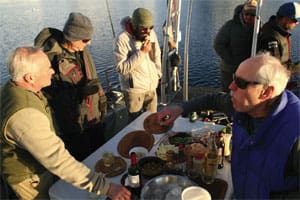In February of 2014, eight men from 56 to 73 years old, mostly from Maine, chartered Skip Novak’s 74-foot sloop Pelagic Australis for a three-week sail from Porto Williams, Chile, to the Antarctic Peninsula.
The idea came from Peter Plumb, who wanted to sail to Antarctica for his 70th birthday. Many of us had sailed with him to the Caribbean, around Newfoundland, or up the west coast to Alaska and back, so we trusted Peter in his choice of shipmates. No rookies or duffers allowed since, at our age, we needed to have confidence in one another’s abilities.
Plumb’s criteria included a steel or aluminum hull, purpose-built and certified for high-latitude sailing; a skipper and crew with extensive experience in the Antarctic on our chosen route; and a vessel that could take eight to 12 guests and was available when we wanted to go. The vessel had to be fully found, somewhat comfortable but not a “cruise ship.” We were, after all, experienced sailors able and willing to stand watches, reef, help in the galley and do what was necessary. Plumb’s prime criterion: to be able to tell our wives, children, partners and friends that the vessel and crew could bring us all back in good shape.
He started his search online and got responses from “we no longer do that” to “not this year,” along with two positive responses. Next he checked “word of mouth” contacts, which led him to Skip Novak’s Pelagic Expeditions. Plumb checked references and was impressed with Novak’s experience captaining four around-the-world races from the late ‘70s into the ‘90s, as well as other long-distance ocean races. Novak and his vessels are certified by Det Norske Veritas, have a Marine and Coastguard Agency (UK) certificate for carrying passengers, and are CE marked. His boats have the permits required by the UK’s Antarctic Act, and he is a member of the International Association of Antarctic Tour Operators, which has established protocols for safe environmental conduct on this fragile continent.
When we boarded a boat taking us from Ushuaia, Argentina, to meet the Pelagic Australis in Porto Williams, we were not impressed with the condition of a few of the boats we saw tied up. Granted, most of them take guests up and down the Beagle Channel or out to the Horn — not to Antarctica — but boat-keeping was not as Bristol as I might have expected. However, as we boarded the PA, our concerns fell away. She was immaculate on deck and below.
To help us prepare for the voyage, Novak sent us information on clothing, medical and insurance requirements, and what we could, and could not, expect once we got underway. One minor hitch: Most medical evacuation policies do not cover anyone older than 70, so it took a lengthy search to find one that would cover all of us.
With the exception of the foul weather gear supplied by the boat, we had to have all our own gear, including seaboots and heavy outerwear to wear off the boat. This meant careful choices and compression bags to get all the gear into our seabags. Since water was limited, eight guests and four crew living 24/7 in long-johns needed frequent changes and sponge baths. Novak’s recommendations were right on, but I could have eliminated a few layers of fleece.
We had a cook but took turns assisting with meals and cleaning up. One of us baked fresh bread almost daily.
Few sailing vessels cross the Southern Ocean to the Antarctica Peninsula; we saw only three charter boats and two private vessels. Peter’s choice was probably on the high end in terms of cost, but it was also on the high end in terms of design, condition and crew. We all agreed with Plumb: “We got what we paid for.”
John Eide sails his 1958 Concordia Yawl Golondrina out of Portland, Maine.

